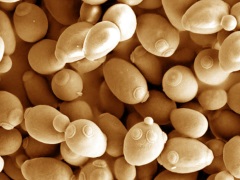Features
Room for improvement
Date: 2018-04-16 16:23:47.0
Author: Jon Evans

Saccharomyces cerevisiae cells.
Photo: Mogana Das Murtey and Patchamuthu
Ramasamy..
An obvious, and regularly explored, way to enhance biofuel production is to come up with improved strains of yeast that are more productive and can ferment a broader range of sugar molecules. But although researchers have been doing this for years, two research groups still recently managed to come up with novel approaches. One involves engineering yeast in a different way, while the other involves looking for yeast in different places.
As genetic engineering techniques have become more precise and sophisticated, scientists have developed ever more yeast strains with enhanced abilities by adding or tweaking genes. But these engineered strains often don’t perform as well as hoped, especially when scaled up for industrial production. This is because the added or tweaked genes often have detrimental effects on the yeast’s health and fitness, increasing metabolic stress and hampering growth.
So when looking to develop a strain of yeast able to ferment xylose, a sugar molecule derived from hemicellulose that yeast can’t normally ferment, Nikhil Nair and Venkatesh Gopinarayanan from Tufts University in the US decided to adopt a different tactic. Rather than try to construct a metabolic pathway for xylose production from scratch in the classic yeast Saccharomyces cerevisiae, they decided to work with what the yeast already had.
Specifically, they decided to adapt the metabolic pathway responsible for the fermentation of the sugar galactose, so that it would instead work with xylose. Previous research had shown that this pathway is an example of what is known as a regulon, meaning a group of genes regulated as a unit. The galactose regulon comprises genes for sensors that detect galactose, signalling molecules that determine what to do with it and enzymes for fermenting it, all under the control of several transcription factors.
As reported in Nature Communications, by simply replacing a few genes, including the one for the sensor, while leaving the others untouched, Nahir and Gopinarayanan were able to convert the whole regulon so that it worked with xylose rather than galactose. Not only would the resultant strain happily ferment xylose, but the modified regulon automatically upregulated growth-related pathways and suppressed genes that responded to stress to maintain the health of the yeast.
"Instead of building a metabolic framework from the ground up, we can reverse engineer existing regulons to enable an organism to thrive on a novel nutrient," said Nair. "Adapting native regulons can be a significantly faster path toward the design of new synthetic organisms for industrial applications."
As well as designing synthetic yeasts, scientists have also been busy looking in a whole variety of places for species and strains of yeast that have naturally evolved enhanced abilities. This approach has the added advantage that such natural yeasts shouldn’t suffer from the fitness and health problems of engineered strains.
Given that mankind first employed yeast for making alcohol, Anderson Sant'Ana and his colleagues at the University of Campinas in Brazil decided to search for novel high-performing yeast in the waste from commercial alcohol production. In particular, they searched in brewers’ spent grains, which are the main byproduct from brewing beer, and waste generated from the production of cachaça, a traditional Brazilian spirit made by fermenting sugarcane juice. As reported in the Journal of Applied Microbiology, they managed to detect a total of 134 different strains from several different yeast species, including S. cerevisiae, Candida parapsilosis and Pichia mashurica.
Sant'Ana and his colleagues then tested the ethanol-producing abilities of 115 of these strains, as the other 19 strains were deemed too sensitive for such testing. This revealed that two of these strains – a strain of S. cerevisiae and a strain of Torulaspora delbrueckii – were even more productive than strains currently used for the industrial production of ethanol from sugarcane. Confirming that, as far as yeast are concerned, there is always room for improvement.
The views represented here are solely those of the author and do not necessarily represent those of John Wiley and Sons, Ltd. or of the SCI.
Displaying 5 keywords used to tag this article:
- come rolex daytona
- Links Of London Bangles
- Moncler Heren Vesten zijn uniek sti
- MontBlanc Princesse Grace : Discoun
- Den Longines Avigation Oversize Cro
